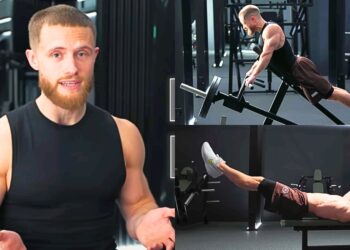Whether you are traveling, just getting into exercise, or need some time off from resistance training, banded exercises might be what you’re looking for. Banded exercises differ from free weight lifts because of their resistance profile. Resistance band exercises get more challenging on concentrics as the tension on the band increases.
Bands can also be an excellent tool for flexibility training, as they allow you to spot yourself in the stretched position. They can provide overpressure in various directions when you aren’t working with a coach.
In this article, I’ll take you over the top 10 banded exercises I have learned over the last 10 years as a physical therapist and strength coach to improve muscle mass and flexibility. I’ll also review the proper techniques for each so you can seamlessly incorporate them into your routine and start reaping their benefits.
5 Best Resistance Band Exercises To Build Muscle Mass
Here are the five most effective muscle-building banded exercises:
1. Banded Strict Press
The banded strict press targets the vertical push pattern and engages most upper body muscles. The exercise primarily targets the upper back’s deltoids, triceps, and muscles.
With any vertical pressing exercise, the main priority is keeping the core engaged and the rib cage down. The rib cage tends to flare to compensate for reduced shoulder range of motion or a lack of core strength.
Level Up Your Fitness: Join our 💪 strong community in Fitness Volt Newsletter. Get daily inspiration, expert-backed workouts, nutrition tips, the latest in strength sports, and the support you need to reach your goals. Subscribe for free!
Ideally, you will brace at the midsection to keep the rib cage down and the abdominals engaged so the arms have a solid foundation to press from.
How To Perform the Banded Strict Press:
- Stand on the resistance band with feet under the hips.
- Hold the band with an overhand grip in a front rack position and hands slightly wider than shoulder width.
- Retract the chin and press the band overhead until the elbows extend fully and the arms move past the ears to full shoulder flexion.
- Lower the band back down to the front rack position and repeat.
2. Banded Push-Up
The push-up is a foundational movement pattern that targets the horizontal press pattern. Although the push-up is a fundamental exercise for anyone looking to improve upper body strength and muscle mass, it can be pretty challenging to master, especially for females who, on average, will have less upper body strength and muscle mass than men.
But, if you possess the scapular and arm strength to perform a push-up, adding band tension to the movement is a great way to add another level of difficulty.
The key to the banded push-up is maintaining total body engagement so that the body moves as a unit without a break at the midsection. You will also want to prevent the quads from contacting the floor to avoid a “worming” action.
The banded push-up can be challenging at the top of the rep, so selecting a slightly lighter band is key.
How To Perform the Banded Push-Up:
- Assume a plank position with the band draped over your upper back.
- Place the hands inside the ends of the band with the elbows fully extended.
- Staying straight from your head to your heels, descend towards the floor.
- Keeping your core engaged and your thigh off the ground, allow your chest to touch the ground.
- Reverse direction to return to the starting position.
3. Banded Good Morning
The good morning exercise is the ultimate hinge-strengthening movement. Since the knees are only slightly bent to relieve tension on the nerves of the lower back and the hips remain high, it is a pure hinge motion with as little squatting as possible.
Using a band, you can overload this pattern and accentuate the lockout position of the movement. A key factor to the banded good morning is positioning the band so it rests at the base of your neck and not over the middle.
This keeps the lever arm of the movement at a comfortable level and reduces any shear forces at the neck that may promote extension at the cervical spine.
Tuck your chin into your upper chest for the entirety of the motion so that the spine remains neutral.
How To Perform the Banded Good Morning:
- Stand on the band with the feet just outside hip width.
- Duck under the band so that it sits at the base of the neck.
- Grasp the band with both hands.
- While maintaining slight knee flexion, hinge at the hips and allow the torso to bend forward, keeping the spine neutral and the chest proud.
- Keeping the core engaged, descend until the hamstrings and glutes tighten.
- Pause at the bottom.
- Reverse direction to return to the starting position.
4. Banded Pendlay Row
The banded pendlay row challenges the entire posterior chain. It primarily targets the upper back muscles, including the lats, traps, rear delts, rhomboids, and teres major and minor. But because of the exercise setup, the hamstrings, glutes, and core also get tremendous work.
When performing the banded pendlay row, you must avoid employing momentum by swinging the upper body as you row. This is common when the load you are rowing is too heavy.
Instead, focus on minimizing the movement of the trunk and isolating the shoulder blades and arms as you pull up on the band and retract the shoulder blades.
Another common mistake is rowing too high to the chest.
Ideally, you should pull on the band diagonally instead of rowing it vertically. This will promote maximal lat engagement and limit upper trap stimulation.
How To Perform the Banded Penday Row:
- Secure the band under your feet with a hip-width stance.
- Grasp the ends of the band.
- Bend the knees slightly and hinge at the hips so your torso is at 45 degrees.
- Pull the elbows towards the hips by retracting the shoulder blades and engaging the lats.
- Return the band under control to the starting position.
- Avoid excessive movement of the torso during the pull.
5. Half-Kneeling Single-Arm Banded Pull-Down
The half-kneeling single-arm banded pull-down is another excellent option for the back muscles and challenges the vertical pull pattern. The banded pull-down simulates machine lat pull-downs but with the added benefit of increasing tension as the arm gets closer to the body.
When setting up for the half-kneeling banded pull-down, position your legs in a lunge stance, ensuring the leading leg is opposite the working arm. This will promote balance and a strong foundation as you pull down.
Level Up Your Fitness: Join our 💪 strong community in Fitness Volt Newsletter. Get daily inspiration, expert-backed workouts, nutrition tips, the latest in strength sports, and the support you need to reach your goals. Subscribe for free!
It can also create an anti-rotation force at the core to increase abdominal muscle engagement.
How To Perform the Half-Kneeling Single-Arm Banded Pull-Down:
- Fasten the band to an overhead structure such as a pull-up bar, squat rack, or closed-door frame.
- Grasp the band with a neutral grip.
- Assume a half-kneeling position so that the opposite leg is in the front.
- Begin the movement with the elbow fully extended.
- Retract the shoulder blade, engage the lats, and pull your elbow toward the hips.
- Continue until the band maximally stretches and the shoulder blade retracts.
- Return to the starting position under control.
5 Best Band Exercises To Improve Flexibility
Check out the five best exercises to boost your mobility:
6. Supine Hamstring Stretch
The supine hamstring stretch challenges the muscles on the backside of the target leg. The hamstrings can become stiff with consistent strengthening or static positioning, such as sitting for prolonged periods during work hours.
Using a band to assist with raising the leg allows you to relax into the stretch as the arms pull on the band. The supine hamstring stretch is a favorite of mine as it will enable you to create the supine stretching position without needing a physical therapist or strength coach to assist you.
How To Perform the Supine Hamstring Stretch:
- Lay on your back with a band fastened around the foot of the target leg.
- Grasp the other end of the band with both hands.
- Keeping the target leg slightly bent to reduce nerve tension, lift the leg as high as you can using the band and arms.
- Continue raising the leg to stretch the hamstrings.
- Keep the opposite leg planted on the floor throughout the movement.
- Hold for several seconds in the fully stretched position and repeat.
Read more: Hamstring Stretches for a Healthier Lower Back and Knees
7. Band-Assisted Pancake Stretch
When evaluating your lower body mobility, forgetting the groin muscles is easy. But when they become stiff, they can create many issues during training. For starters, a muscle imbalance between the adductors (groin muscles) and abductors (glute muscles) can contribute to valgus collapse during the squat position, where the knees move inward during the ascent of the squat. (1)
They can also limit your ability to get into certain positions needed for strength training, such as during sumo deadlifts. Tight adductors can restrict how wide your stance can be, increasing the distance the barbell must travel to complete a rep.
How To Perform the Band-Assisted Pancake Stretch:
- Begin by fastening the band to a squat rack or column at mid-shin height.
- Assume a seated position in front of the band with the legs in a “V” position.
- Position the band in the middle of the legs and grasp the band with both hands.
- Keep the torso upright, hinge at the hips, and lower your torso to the ground between your legs.
- Pull on the band with the arms to create over-pressure towards the ground.
- Continue until you feel a stretching sensation in the hamstrings and lower back.
- Hold for several seconds and repeat.
8. Banded Lateral Hip Mobilization
The banded lateral hip mobilization is one of my all-time favorites for addressing restrictions in mobility at the hip. Sources of mobility restrictions can range from tight muscles to immobile nerves and tight joint capsules. (2) The joint capsule is a fibrous sheath surrounding all synovial joints.
The joint capsule provides another level of stability to the joints, which is a good thing. Still, just like muscles, it can become stiff and hinder motion or cause discomfort. (2) To mobilize a joint capsule, the direction of force is important, as specific mobilizing forces will address different points on the capsule and improve different movements.
However, a lateral distraction such as the banded lateral hip mobilization will improve all aspects of the capsule and benefit all motions. (2) Thus, the banded lateral hip mobilization is a massive bang for your buck exercise.
How To Perform the Banded Lateral Hip Mobilization:
- Fasten the band to a squat rack or beam of some kind at knee height.
- Place the target leg into the band and step laterally so that there is tension in the band.
- Assume a lunge position with the target leg up and the opposite leg extended behind.
- Move as far laterally away from the rack as possible to increase the outward pulling force of the band.
- Place the hands flat on the ground and let the band distract the target hip laterally.
9. Banded Anterior Hip Mobilization
The anterior hip mobilization is another great banded mobility drill to address tightness in the joint capsule. In this exercise, you address tightness in the front of the hip, which can be detrimental for exercises requiring full hip extension. (2)
When the front of the hip capsule becomes tight, it can reduce the amount of hip extension that occurs and cause compensations of increased shear forces on the lower back, resulting in pain (2). As far as exercise is concerned, limitations in hip extension can reduce the power you generate from the glutes and reduce how effective your muscle-building endeavors are.
With the anterior hip mobilization and the lateral hip mobilization, you should use a band of the highest tension possible. This way, you can simulate the force of someone else applying pressure to the joint and have enough of it to push through the other tissues and reach the joint capsule.
How To Perform the Banded Anterior Hip Mobilization:
- Position the band on a squat rack or column at mid-thigh height.
- Place the target leg into the band.
- Assume a lunging position with the target leg down.
- Move away from the squat rack so the band is taut and a forward pulling force is applied to the target leg.
- Keeping the pelvis neutral allows the target hip to extend and the band to provide overpressure into hip extension.
10. Banded Overhead Tricep Stretch
The banded overhead tricep stretch challenges the triceps and lats. The tension created in the band as you stretch overhead provides overpressure into elbow flexion and shoulder flexion. The shoulders can become tight as you strength train and accrue muscle mass around the upper body.
This can be problematic when trying to perform exercises like the banded strict press, barbell strict press, and other vertical pressing motions. The banded tricep stretch helps mitigate this. A key consideration with the banded overhead tricep stretch is staying engaged through the core. It is common for clients to lose tension in the midsection and allow the ribcage to flare when the lats and shoulders are tight.
Doing so is a compensation to allow the upper arm to get vertical, but it also decreases the effectiveness of the stretch. Instead, keep the abdominals braced and the rib cage down as the arm travels up as high as it will go naturally.
How To Perform the Banded Overhead Tricep Stretch:
- Stand on the band with the same side leg as the target arm.
- Grasp the other end of the band and position the shoulder fully flexed and the elbow bent behind you.
- The band should remain behind the body.
- Allow the band to create overpressure on the target arm into shoulder and elbow flexion to stretch the triceps.
- Maintain core engagement.
FAQs
How often should I incorporate resistance band exercises into my routine?
According to the World Health Organization, you should engage in muscular strengthening activities at least twice weekly (3). Resistance training with a band fits this category, so feel free to incorporate it multiple times throughout the week.
Can resistance bands replace traditional strength training equipment?
The main factor to consider when building muscle mass is creating muscle tension, damage, and progressive overload (4). You must challenge the muscles and progressively make things more complex in some way. Thus, bands can be a great option to access traditional training equipment.
Are resistance band exercises suitable for beginners?
Yes! Band use can be an excellent option for beginners because they are relatively lower in load than external weights so you can experiment with various movement patterns with a low risk of injury. As you become more comfortable with the exercise, you can progress in band tension and switch to barbells and dumbbells.
Final Thoughts On Resistance Band Exercises
My top 10 band resistance exercises were to improve muscle mass and flexibility. They have been my bread and butter when prescribing exercises to my clients if they don’t have access to traditional training equipment, are choosing to train at home or need a change from the barbell.
Don’t mistake them for being easy or ineffective because they are not using barbells or dumbbells. They pack the punch and can lead to decent strength and muscle mass gains. Now, incorporate the demo videos and points of performance into your workout routine and see for yourself how effective they are.
References:
- Wilczyński, B., Wąż, P., & Zorena, K. (2021). Impact of Three Strengthening Exercises on Dynamic Knee Valgus and Balance with Poor Knee Control among Young Football Players: A Randomized Controlled Trial. Healthcare (Basel, Switzerland), 9(5), 558. https://doi.org/10.3390/healthcare9050558
- Reiman, M. P., & Matheson, J. W. (2013). Restricted hip mobility: clinical suggestions for self-mobilization and muscle re-education. International journal of sports physical therapy, 8(5), 729–740. https://www.ncbi.nlm.nih.gov/pmc/articles/PMC3811738/
- World Health Organization. (Year, Month Day of publication). Physical Activity. WHO. https://www.who.int/news-room/fact-sheets/detail/physical-activity
- Schoenfeld B. J. (2010). The mechanisms of muscle hypertrophy and their application to resistance training. Journal of strength and conditioning research, 24(10), 2857–2872. https://doi.org/10.1519/JSC.0b013e3181e840f3








